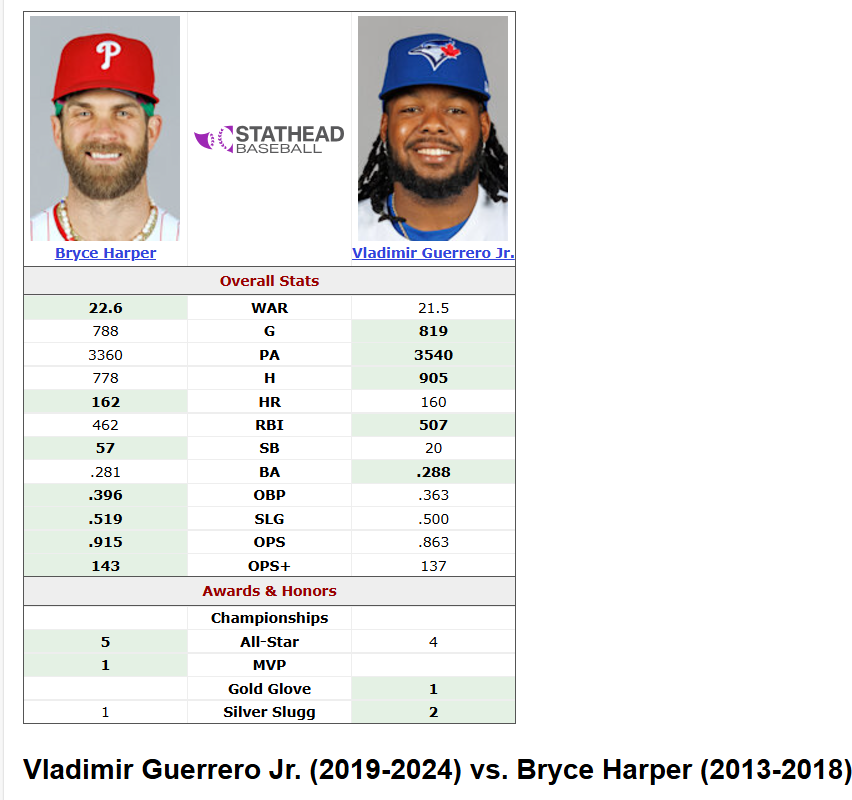I remarked (in the bad place) a couple of months ago that for all the beat reporters and pundits and "insiders" that are asked to speculate about what it would take to extend Vlad Guerreo Jr's contract through the rest of his career none of them ever reference what, to me, seems the most blindingly obvious comp.
I'm recycling and expanding upon that thought here because it still seems to me to be really obvious.
There's a player out there right now, playing the same position (now) who signed at the same age that Vlad will be this offseason and their production through their age 25 season is stunningly comparable. Take a look:
Vladimir Guerrero Jr. (2019-2024) vs. Bryce Harper (2013-2018): Head-to-Head Stats Comparison | Stathead.com
It's Bryce Harper, y'all. It couldn't be more obvious.
I mean, I get bringing up Rafael Devers as a more recent comp but the match is not really as clean. It's instructive in some ways as a guide to what contract inflation would look like, but in terms of age and production and anticipated future value, you can't do better than Harper. And you certainly can't suggest he'd be in the stratosphere with Soto.
It's true that Harper was a right fielder at the time, and that adjustment matters some but that tends to get washed away by the inflation anyway. After all, Vlad's whole major league career has come after Harper's deal was signed. The nature of this game is that the contract structure always spirals upward.
So, what was that contract? 13 years, $330 million, 25.38 million AAV
The breakdown on Cott's is slightly different from what you see above, with a $10 million first year, nine years at $26 million, and the last three at $22 million. And with a $20 million signing bonus which BR amortized over the length of the deal. But it adds up the same. For the purpose of this exercise I'll lay aside potential bonuses and such.
That contract is still the 8th highest ever signed in total value (pending Soto's) and only two of those higher than his are infielders.
So here's my framework:
First, take Harper's deal and add a 14th year (for enough to raise the AAV to at least $26 million) - that takes your total to $364 million. That would make him the highest paid infielder in the majors by total contract value and 4th overall, for now. That's just ONE million behind Mookie Betts so let's add $2 million more and that would make him 3rd overall (until Soto). There would be five infielders with a higher AAV, all of them shortstops except former SS Manny Machado, and Deavers.
That would sign him through age 39. My inclination would be to limit the first two seasons (until Springer is off the books) to something like $24 million each, and to taper off the last four to something like $20 each (on average) knowing that $20 million in 2038 will be a lot less money than it is now. Make $10 mil a signing bonus, another $10 million deferred (or a secondary payment on the signing bonus in, say, five years) and what's left works out to $27 million a year through the eight years on average, that would presumably be the heart of his productive years. Maybe given the arb estimate you do $30 per for years 3-6 and $17 million in those last 4 years? But now I'm into the weeds. If you just had to in order to make the deal, give him an opt out halfway through but I'd rather not.
So he ends up making more than his best comp, holding the biggest deal ever for an infielder and the third highest AAV for an infielder who's not a SS. And the fourth overall (which will be 5th by opening day). I feel like that checks enough boxes to get it done.
I'm sure some will say "Too much!" and maybe if you were signing a guy away from another teams as the Phillies did Harper you'd have to really ponder. But right now and for the rest of his career if you get this done, Vlad *IS* the Toronto Blue Jays. You either go to the wall to keep him or you strip the whole thing down to the kids and start over.
Let's not.

